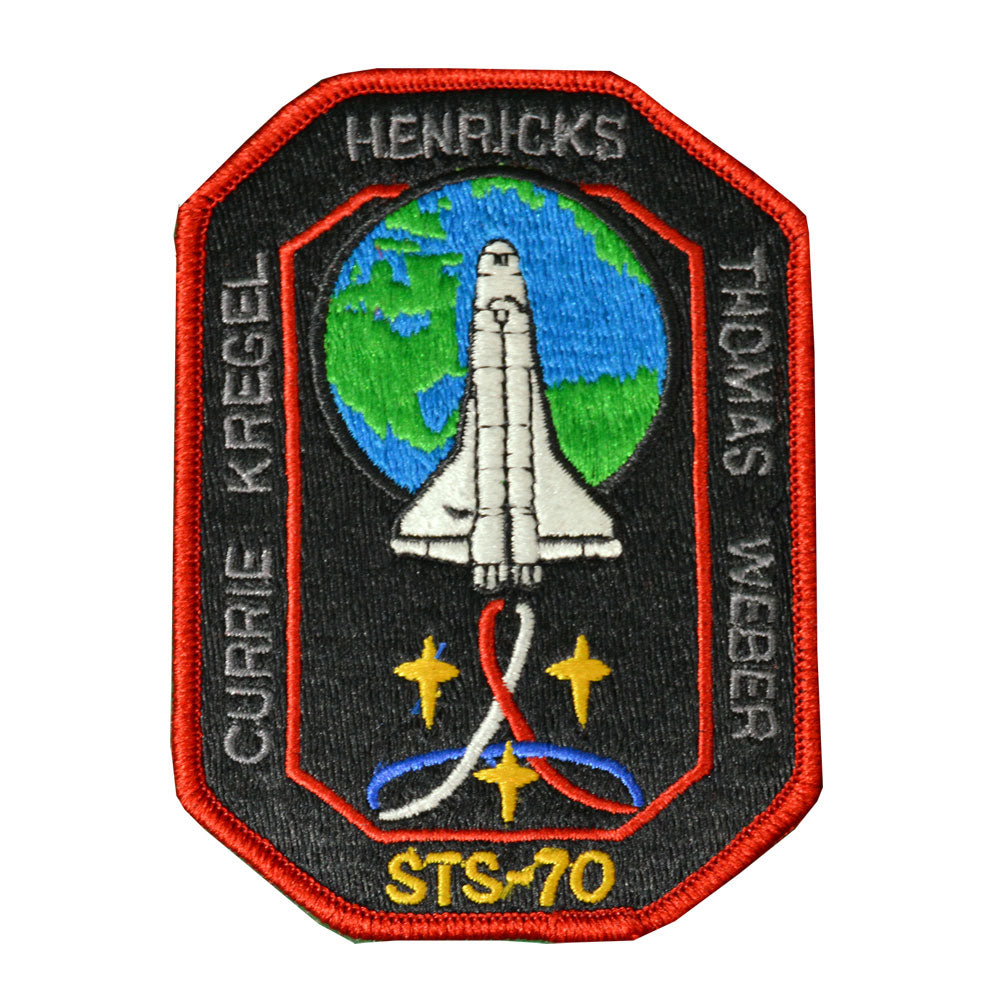
STS-70 Patch
Mission Highlights
Primary objective of the mission accomplished when Tracking and Data Relay Satellite-G deployed from orbiter payload bay about six hours after liftoff. Approximately one hour after deployment, Inertial Upper Stage (IUS) booster attached to TDRS-G completed first of two scheduled burns to place TDRS-G in geosynchronous orbit. Once it completes on-orbit checkout, TDRS-G will become operational spare, completing existing TDRS network of advanced tracking and communications satellites.
During remainder of mission, five crew members completed variety of experiments. Biological Research in Canister (BRIC) experiments study effects of microgravity on wide range of physiological processes in plants, insects and small invertebrate animals. BRIC-4 examined how hormone system and muscle formation of tobacco hornworm affected by microgravity; BRIC-5 tested whether cell division changes in daylily are due to microgravity or other causes. Also, Bioreactor Development System (BDS), composed of device developed at Johnson Space Center, used colon cancer cells to test bioreactor performance in microgravity; this experiment worked extremely well, yielding tissue cultures better than any seen previously.
National Institutes of Health-R-2 featured suite of experiments examining how microgravity affects different aspects of rodent pre- and post-natal development.
Commercial Protein Crystal Growth (CPCG) experiment featured Protein Crystallization Facility (PCF) on its eighth flight. Five of these flights have yielded space-grown protein crystals of superior X-ray quality. Human insulin crystals grown on SPACEHAB 1 and 2 missions yielded most detailed analysis ever made of this protein, which is key medication used to treat diabetes. Industry now using this structural information to develop new and improved time-release insulin formulation. On STS-70, crystals of alpha interferon protein — used to treat human viral hepatitis B and C — were grown.
Other experiments: Space Tissue Loss-B (STL-B), studying effect of microgravity on embryogenesis; and Hand-Held, Earth-Oriented, Cooperative, Real-Time, User-Friendly, Location Targeting and Environmental System (HERCULES), a space-based geolocating system that features video camera and electronic still camera to document locations on Earth and tag every frame with latitude and longitude to within three nautical miles. Crew had difficulty at first aligning HERCULES camera, but eventually obtained 95% of planned photographic targets.
Also, Microencapsulation in Space-B (MIS-B), making its second flight aboard the Shuttle. MIS-B designed to produce better microencapsulated antibiotic; this type of antibiotic has proven extremely effective in treating wound infections, as it releases antibiotic at precise and predictable rate to cure infection. First flight of MIS-B yielded purer microcapsules than could be obtained on Earth, but only a small quantity was produced. Researchers hoped second flight of MIS-B on STS-70 would yield greater quantity of antibiotic.
Midcourse Space Experiment (MSX) required no onboard hardware; military MSX satellite used Shuttle during mission as tracking and calibration target. Military Applications of Ship Tracks (MAST) required crew to photograph ship tracks as part of effort to determine how pollutants generated by ships modify reflective properties of clouds. Radiation Monitoring Equipment-III (RME-III) is prototype dosimeter instrument which has been flying on shuttle since STS-31, and measures exposure to ionizing radiation on shuttle; data from RME-III is archived and used to update and refine models of space radiation environment in low-Earth orbit.
Objective of Window Experiment (WINDEX), another military experiment, is to gain understanding of chemistry and dynamics of low Earth orbit by collecting variety of data about such phenomena as shuttle thruster plumes, water dumps and atmospheric nightglow.
Visual Function Tester-4 (VFT-4) designed to gain better understanding of whether astronauts’ vision is affected by microgravity. VFT-4 instrument measures eyesight at near- and close range to test theories on what happens to human eye in space. Astronauts since Gemini days in early ’60s have noticed that in space it takes longer to adjust and focus on near objects, and STS-70 crew confirmed this observation.
Crew also spoke with ground radio operators as part of Shuttle Amateur Radio Experiment (SAREX), counting around 50 contacts a day for several days of flight.
No significant problems were experienced with the orbiter. STS-70 marked first flight of new Block I main engine featuring new high-pressure liquid oxidizer turbopump built by Pratt & Whitney. Engine 2036 flew in number one position; other two main engines were of existing Phase II design.


